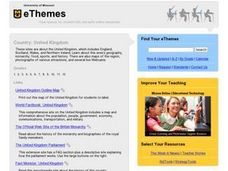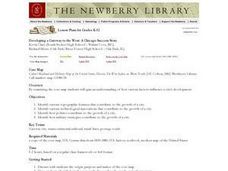Curated OER
Country: United Kingdom
Students use the Internet to examine the food, sports and history of England, Scotland, Wales and Northern Ireland. They view photographs and maps.
Curated OER
North and South
Young scholars study the Civil War and the changes it brought to our country. They examine some of Robert E. Lee's accomplishments and the contributions he made as president to Washington and Lee University. They make a map showing which...
Curated OER
Persistent Paths: Trails, Tracks and Turnpikes Across the Alleghenies
High schoolers study maps to determine barriers associated with the Pennsylvania mountains and the Native Americans. In this investigative lesson students study the routes used by Native Americans, explain physical features of the...
Curated OER
Preservation of Civil War Battlefields
Eighth graders examine the importance of battlefield preservation. In this US History lesson, 8th graders participate in a virtual tour of battle sites. Students create a map of Gettysburg to see the topography of the battle...
Curated OER
Revisiting the Somme
Students consider how the military folly of the Somme during World War I. In this World War I lesson, students visit selected websites to discover information about the Somme, propaganda, and their effects on the...
Curated OER
Comparing the Similarities and Differences of Medieval Castles
High schoolers compare and contrast a Japanese castle with a Welsh castle. In groups, pupils use the internet to research specified topics on a castle. They explore the government, construction and military function of the area. ...
Curated OER
Locating The Cold War
Students identify major players in the Cold War and place them on a world map. They identify the two superpowers location on the map as well as their allies. Students analyze how the world divided itself.
Curated OER
Spanish-American War
Eleventh graders identify and examine the main causes and effects of the Spanish American War. They explore yellow journalism and investigate the history to the Platt Amendment. Each student also defines imperialism and maps out the...
Curated OER
Richard Misrach
Students analyze the Great Salt Lake as a resource for artistic work and other studies. In this art analysis instructional activity, students view maps that show the location of the Great Salt Lake including a satellite image. Students...
Curated OER
Civil War and Reconstruction
Fourth graders investigate the Civil War by researching the state of Virginia. In this US History lesson, 4th graders identify Abraham Lincoln, James Chestnut and Fort Sumter, and discuss their roles in the start of the Civil...
Power Show
Colonial North America
This 54-slide PowerPoint outlines the significant events in the history of Colonial North America, beginning in 1603 with the ascendance of James I to the throne of England. Designed to accompany a lecture on this time period, the...
Annenberg Foundation
A Growing Global Power
How does a nation turn into a global superpower? The 16th installment of the 22-part series on American history investigates the rise of the United States to global importance in the late nineteenth and early twentieth centuries. Groups...
Curated OER
Iwo Jima: Forgotten Valor
Students explore the nature of island combat on Iwo Jima during World War II. They examine the association between the Pacific Theater of World War II and Iwo Jima. Students evaluate Charles Lindberg's oral history, propaganda posters,...
Curated OER
Brick by Brick
Students use their previous knowledge of the Pyramid Lake War to help them analyze different primary sources of Fort Churchill. In this source analysis lesson, students work in groups to study 4 different primary sources for Fort...
Curated OER
A Troubled Relationship
Students discover information about Iran and Britain. In this current events lesson, students visit websites and listen to lectures to learn about Britain's Navy personnel that were taken hostage by Iran. Students investigate the history...
Curated OER
Developing a Gateway to the West
Students identify various topographical features that contribute to the growth of a city. They identify how military strategies contribute to the growth of a city.
Curated OER
Fort Hancock and the Sandy Hook Proving Ground Historical District
Students examine the history of the United Stated defending the coast line. They also analyze how military technology has changed the way the coasts are defended. They discuss how military expenditures have affected their community.
Curated OER
War With Iraq
Students research a variety of magazine articles on the issue of Iraq and conflict resolution. Students chart the costs and benefits of the military action. Students prepare a rough layout and draft some content findings on the...
Curated OER
Fort Pickens and Fort Barrancas Historic District
Students use maps, readings, photos and diagrams to identify and describe events in Pensacola, Florida that preceded the Civil War. They examine the role of Fort Pickens during the Civil War and consider the community impact of military...
Curated OER
Florida During World War II
Second graders list reasons why Florida was ideal for building military bases, then explain why America entered World War II. They list reasons why Florida was ideal for building military bases.
Curated OER
A Nation in (Some) Context
Eleventh graders view selected websites to gain information about Puerto Rico and think about its relevance to Rafael Ferrer's "12 Variations on An 18th-century Map of Puerto Rico".
Curated OER
North Carolina Place Names
Fourth graders examine a map of North Carolina to discover the heritage left behind in the names of various places. They compare/contrast those derived from Native American culture to those derived from European settlers.
Curated OER
Latin America: Places and Regions
Seventh graders create a Latin American portfolio in the form of a country presentation using PowerPoint software. They use their knowledge of geographic concepts to interpret maps, globes, charts, diagrams, and timelines.
Curated OER
The English Settle America
Sixth graders compare immigration today with that of the colonial period. They locate colonies on a map and describe reasons their families immigrated to the United States.

























